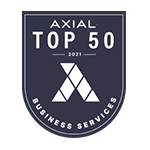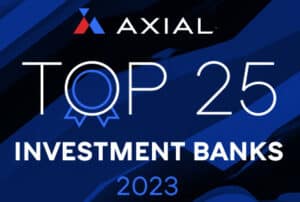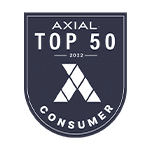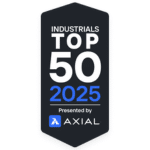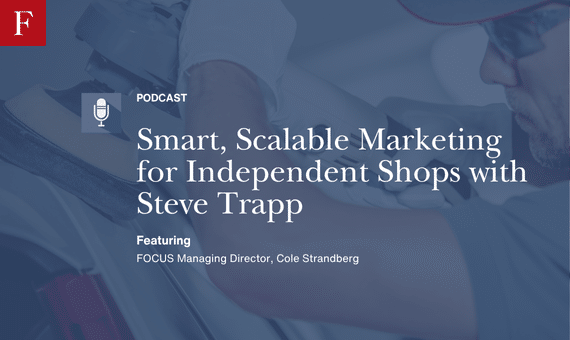
Smart, Scalable Marketing for Independent Shops with Steve Trapp
On this week’s episode, Cole Strandberg chats with Steve Trapp, a collision industry veteran. During this conversation, Steve shares how independent operators can take full control of their marketing—before they ever spend a dime. From CRM-driven outreach and upsell opportunities to referral strategies and partnerships with insurers and agents, we’ll break down the fundamentals of smart, scalable, and affordable shop marketing.
Listen and Follow The Collision Vision.
Cole Strandberg: Man, yours is a name that I’ve seen all over the place for a long time and I gave a little bit of an introduction about you at the top of the show, but would love to hear about you and what you have going on in your own words.
Steve Trapp: Well, I guess started out, family had a Body Shop in Wisconsin. I ended up talking to the Three M Rep Thought that was a cool job and I went to work for Three M kind of got on in the three M arms role, which is auto body repair management system, learned a lot about systems in the business, got into some consulting later in the experience working for Danny Kiara and then accident of all came calling and they said they were going to start the industry’s first, you know, basically a performance group and value added program. So I started that for them in 1989. Ninety and I went on to work for DuPont Exalta after that and then just recently switched on to team PPG and I’m now doing strategic accounts for regional and national independent and dealer 20 groups or groups. So working like that should be a lot of fun.
Cole Strandberg: Fantastic. Yeah, Congratulations again on that. That one made a ton of waves, was the talk of the industry and still is at this point. Let’s let’s jump in. I mean you, you’ve been a facilitator of some of the Premium 20 groups out there, many guests here on the Collision Vision. You’ve been involved in a lot of their success. So excited to dive in today. Not that this really matters to our listeners, but you and I are going to record back-to-back for two separate series today. Obviously we’re here to talk about marketing primarily and we had a great pre show call that I’m excited to dive in. So with that, let’s start at the kind of the top of the funnel. Why do you say the easiest way to grow sales is through the customers that are already walking in the shop? It’s not necessarily what we think when we think of marketing, but it’s it’s right there.
Steve Trapp: Yeah. I mean, if you think about it, yeah, obviously closing ratio or closing the folks that are walking through the door is super important. But even prior to that, it’s, it’s answering the phone, it’s following up on your assignments promptly, It’s getting those AI estimates written on, on the images that you’ve asked them to send and really getting that customer care culture built from the moment they make the first phone call through the moment they walk into the door. And, and obviously, you know, if, if you’re only closing 60%, that means 40%’s an opportunity to close more. And so there’s no additional money to get more people to walk through the door. You just got to do a, a more effective job and having a sales culture. A lot of the shops through COVID and so forth became what I call DRP lazy. And that means that they, they kind of lost focus on, you know, really what was important, which is the customer and the experience. And it became about what’s your claim number? And so we’ve got to really get everybody to rethink that sales approach and then be customer focused as they as they go about their duties.
Cole Strandberg: That mindset shift during COVID, I think you, you couldn’t have said it better. It was man, we got such a backlog, you’re a number keep it moving through. And obviously now the landscape is shifting. That was never gonna stay around forever. But that opportunity that we’re missing the, if we’re capturing 60% and and there’s another 40% we can get just by being cognizant of that. I mean, I don’t think there’s anyone listening here right now that would say no thank you to a 40% growth in sales, for example.
Steve Trapp: Yeah, if you, one of the statistics we haven’t chatted about, but it’s very telling is customer pay during the COVID times 5%, it’s now 32%. So the claims volumes the insurance companies are seeing are off 23% as those people now have high deductibles and don’t want to turn those claims in. So it’s shifted the entire landscape and really kind of refocused everyone. And I think a lot of the shops that were DRP centric are saying, hey, where’s all the work ’cause they’re used to getting getting it assigned to them. It’s still calling. It’s just are you, are you, you know, guiding it to the shop and are you welcoming it to the shop or are you kind of saying, hey, this, I’m ADRP shop and I don’t have an interest in that customer pay work. So just an interesting change in the landscape recently.
Cole Strandberg: Most definitely a great stat and and opens up so many questions. I will say going back to kind of your first response, you mentioned sales sort of in the same breath as we mentioned customer service. You and I come from a sales background. So sales might not have the negative connotation for us that it would for others. I think the word sales might bring up that slimy used car salesman and and things of that nature. How can shops begin to build a true sales culture without being at odds toward that customer thrust or quality approach?
Steve Trapp: I would look back to the maybe the 1990s when General Motors basically had it scented their estimators to be more focused or cognizant of, you know, the, the upselling, the, the, the transmission flush or whatever. And they stopped really being advisors and giving good advice. And so the thing that I would tell you is that a good salesman is a good advisor. They’re basically offering advice to the customers, what’s best for them, not necessarily for the shop. And the customer perceives that they’re looking out for their best interest. And again, it’s kind of an, an axiom that probably overused, but you’re their friend in the business. You’re the person that’s going to say, here’s the advice I would give you as a shop owner, but also your friend. This is an honest to goodness approach to this. I’m not trying to sell you something. I think I’m going to do a quality repair and I think I ain’t going to do enough timely fashion. I’m we’re going to treat you with respect. So the key here in my mind, frankly is, is the advisory sales tactics that are used.
Cole Strandberg: A consultative approach, you’re helping them out. It just happens to be a win win type scenario. Talk to me about because something I love whenever we speak is it’s very actionable, rubber meets the road type stuff. What are some practical ways that shops can start to implement this this consultative upselling into their approach?
Steve Trapp: Probably the easiest way to look at it is just like anything in marketing, you want people to opt in it in. So it’s their choice that if, if you if they feel like, hey, you’re throwing in a Ding or dent estimate and and they didn’t approve it or ask for it, they feel like you are being that slimy salesperson. So what I would say is, Hey, I happen to notice there’s a door Ding as they walk by. Would it be OK if I gave you a price on that to fix it? And I use the term here in quotes, air quotes while you’re here. OK, because this car is already in the spray booth. The cars are in The Body Shop, the car is already going to be detailed. The car is already going to be pre washed, the car is going to be scanned. So those parts will all be done anyhow. So we can give you a better price if we do it while you’re here. And so I think that’s number one. Number two, relative to this is like upselling a detail package. Most of us are super busy, especially young parents don’t have time to keep the the car as clean as we’d like. So pay for a little extra money. Would you be interested in having us detail it or I’ve noticed your tires are bad. You know, obviously the car is going to be off through it anyhow. I could get those tires replaced while you’re here again again, everything trying to do it while you’re here. So we’re you’re fixing an insurance claim or fixing a repair claim, we could do those things while you’re here. It’s going to here’s the key. All second second key is it will add value to your vehicle. Your vehicle will smell better, feel better, feel new. You’re going to feel better about it. The point here is that you’re not if you, if you got a guy that’s driving around in a old Chevy pickup truck that’s rusted out, don’t try and upsell them. That’s not the person that you’re trying to upsell. You got to read the customer, understand their needs, understand they are a busy professional or a busy person. They don’t have time to do some of these things and they would like to have a nice car. You know how long you going to keep the car? I mean, some very simple questions we said to basically get them to think about this. And again, I like to give a 10% spiff to the estimator and to the detailer for doing a good job. Because at the end of the day, they’re going to have to sell it. They’re going to have to resell it after, and the detailer is going to have to do a really nice job. So people keep coming back for a detail. So again, a little incentive for everybody in the value chain at the same time as you, like you said, a win, win for the customer.
Cole Strandberg: I love the incentive idea. Are there any other ways, obviously you get ownership and leadership to buy into this sales consultative culture? Any other insights or advice as to how to get the team at the the ground level to go ahead and say, hey, yeah, we’re all in on this culture shift?
Steve Trapp: Yeah, I think the big key here is a level schedule. So if your schedule is 50 in, 50 out out, 50 paint labor, body labor, total labor hours, however you do it, or vehicles, 5 vehicles, 4 vehicles a day. If you’re delivering 14 on a Friday and you’re telling me to do a nice fancy detail on top of it, it ain’t going to work and the team’s going to scream at you and say what are you doing? But if you have a level schedule and a level in and out flow, then hey, it’s just a little extra work on those four or five cars are leaving that day. That’s very doable. The same thing is true of any Dings and dents. If it’s sold upfront, before they ever got disassembled, before it ever got into the paint booth, before it ever got somewhere, they’re going to be all over it. But if you call the customer saying, hey, we’re just about to pull in the paint booth and I noticed you got a scratch in the door, it’s like the body guys, I already did the body work, you’re going to send it back to me. And so the idea is it’s all about pre selling at the time of the initial inspection or certainly the time of drop off.
Cole Strandberg: Love it. And keeping in the vein of of making the most out of the customers who are in your shop or who maybe were at some point in your shop, how should we view using CRM systems to stay connected with some of these customers and even generate some referrals?
Steve Trapp: Yeah. So CRM is an interesting thing. Is it in basically innate in it is fixing the car right and getting it done on time and then reselling it to the customer? And so if you’re aren’t, you aren’t doing a active delivery where you’re really truly reselling some benefit you provided them. You need them to feel like you did something special for them, whether it be to give them a ride home, you fix the little scratch on the door for free, whatever you did and maybe just really did a nice job of the detail. I mean, or man, that that paint shines or it matches very well, but give them something specific so they’ll remember that when you ask them for the repeat for the refer. So they go, man, there is a reason why I’m doing this. Otherwise they’re like, it was just a experience and they’re not going to mention other friends. Then obviously because we’ve got the CRM systems or customer relationship management systems, they basically are able to go, wow, I have a relationship with the shop. They’re my buddy and the my friend in the business, right? So I’m going to be in touch with them a day or so after say, how did I do? Did I do a good job? It doesn’t necessarily have to be ACSI. It’s just I want to check on you and your car. Do you feel good about what you got? Then 30 days later, hey, how’s it looking? Is, is everything operating like it’s supposed to 90 days later, Hey, everything still working the way we talked about and then a year later, remember you’ve got a lifetime warranty, feel free to bring it in. So and then next that relationship could could go on and on with spring scratch and den specials and things like that. But don’t if you’re going to spend the time to do a really nice job with the customer experience and the delivery process. Don’t miss the opportunity to mine the gold that is your customer database that’s out there.
Cole Strandberg: Fantastic, man. We first spoke and we talked about kind of this marketing oriented conversation. You were very quick to point out we need to focus on the basics #1 there’s all sorts of different strategies and tactics we can deploy that are going to cost a lot of money, but there’s a lot of stuff that’s right down the middle. So I want to spend some time focusing on the basics. And with that, what are the key website must haves that every shop should be prioritizing before they even spend a single marketing dollar?
Steve Trapp: Great question. I think the we all know that the lobby of our shop is a key to our business, right? We know when people walk in the door, it sets that first impression of the business. And so our website should basically be the same way. And, and ultimately it’s the, it’s the first impression even before they walk into the shop because most folks are, are tuned now to basically going out, doing a little web research, looking at the, the website of the shop before. So some of the key things I would say is, you know, tell a little bit of the story about you, what you stand for and what your beliefs are. I think that that needs to be there. Obviously people look for the address and the hours of operation. So that’s definitely got to got to be there. Obviously the shop tour on some form of either video or pictures to kind of show some things folks like before really good before and after photos. So that can it can be done people, some people even use video for that. The ability to go online and schedule an inspection site or an estimate for their for their car, the ability to upload their images to the to a website. So they can very conveniently be able to do that and possibly even sign a work authorization. So anything we can do to make it easier for them to interact with us. And obviously even employee employees that are dialing in. But the whole key here is you want to have them perceive that they fully understand the type of shop you are, what you stand for, and the fact that you’re convenient and willing to give them whatever permission they need, even it to include what to do in case of an accident. So nice little section on that’s good.
Cole Strandberg: Love that and and two things that I want to ask as well on the website specifically, how should shops be leveraging and promoting their OE certifications?
Steve Trapp: Yeah, a lot of consumers don’t understand OE certifications, ICAR, gold status and other things. So it’s important to be somewhat iterative or literal on that. So give them some definition or explanation. Doesn’t have to be paragraphs of information, but just something that says I am always certified with Toyota. That means that we can offer you this. Make it about them, not about what you did or your certifications. They don’t need to know that you had some guy take a picture of your frame rack certification numbers. They want to know that what does that mean to me as a consumer that you have that frame rack, that you have the proper diagnostic equipment that you have, you know, up to date scan tools and all that kind of stuff. So I think it’s important to do it from the customer’s perspective, not from your own.
Cole Strandberg: You mentioned that the website should sort of be the lobby of your online presence. Talk to me about the lobby itself. What should customers see and feel when they walk through the doors into your shop?
Steve Trapp
I would tell you that if you walk in your shop and possibly you did the remodel in 90s or early 2000s, go back and really relook at it. Say it did it look good in 1990 or 2000s? Yes it did. Does it look the same now? Yes, it does, which means that it’s out outdated. And I walk into a lot of shops, they’ve spent a lot of money back then and they’re proud of it. But it’s gotten old. It’s gotten tired, it’s gotten dusty, it’s gotten dirty. So I think modern, modern image to your company style. I mean, some people are into, you know, old, old cars and that theme, that’s OK too. But just be very tasteful about it. And the key here is to avoid putting other companies in your lobby like rental car companies, tow companies there. That’s their business. You should be selling your business and keeping the message very simple, saying these are our certifications. These are my texts and their certifications. These are our community involvement, our accomplishments, the awards we’ve won. Here’s the things that we do for the community. The point is, is keep the message succinct and simple and professional. But don’t, don’t be, don’t be, don’t be kind of, you know, satisfied to put up with maybe an old style or old, old fashioned office.
Cole Strandberg: Super helpful, super actionable. You’re a big relationship guy. If if I know anything about you, it’s. It’s the importance of relationships and there’s so many different relationships that make an impact on body shops and collision repair businesses. One such relationship is the relationship with insurance providers. So how can shop owners, from your perspective, use insurance, relationships and scorecards as an asset for their marketing?
Steve Trapp: I don’t know if I share this with you, but I have on my names on the patent for the insurance scorecard. I wrote it in the, in the mid 90s and our whole, the whole vision for the balance scorecard was to have more than price or the, the cost of repair to be the standard, OK, Now the, the insurance scorecard are like the rules of a game, right? So each customer, each company, each fleet, each insurance company has their own rules, OK? They’ve defined the, the indices that matter to them and they’ve assigned point values to them. So it’s important to understand what each carrier values and, and adds value to as far as points. And that’s important for you to look at where you stand in your local marketplace and those things that that they value the most. You should obviously try and make your numbers to win look the best, right? And I find that a lot of shop owners don’t go and look at these things monthly, even quarterly. Some guys don’t look at them hardly at all and and that’s kind of silly because someone has laid out the rules and said it’s not about the, the, the race to the bottom by having the cheapest price. It is not. That’s the beauty of what the scorecard was supposed to do. You’ve got quality, you’ve got Net Promoter score, you’ve got on time delivery, you’ve got all these metrics that you can do well that aren’t price. OK, doesn’t mean that you can’t be sensitive to price, but ultimately a win, win, win relationship says the consumer wins, you wins and the insurance or fleet company wins. It doesn’t need to be a lose for any of the parties. You just need to understand what they value and try and work to achieve the best score.
Cole Strandberg: Something I love about the collision industry, just from like a business fundamental perspective is yes, it’s, it’s retail, right? There’s a, a, a shop environment, there’s retail frontage and a lot of situations, but it’s also a sales organization where if you’re slow, you don’t have to wait like the smoothie store down the street for someone to walk in and, and buy something. You can go out and proactively get it. And that can be done through DRP and insurance relationships, fleet accounts, and importantly, some of these dealer relationships. Talk to me about some of the right ways to proactively engage with dealership partners and then the OE certifying dealers as well.
Steve Trapp: Yeah. So it’s a it’s a tricky issue because obviously if they have a Body Shop, you’re asking them to close down their shop or send less work to their shop. So you know, those are the more difficult scenarios. When they don’t have that, however, is when you have every opportunity to really go in and showcase what you’re good at, whether it be quality, whether it be or could be multiple factors like qualities, then it could be on time, it could be reasonable price, it could be our repair approach. Whatever it is, you got to know what it is that you’re good at and. And listen to what they need. If they’re saying my cars don’t come back a very timely and I I’m trying to deliver new cars that maybe have a scratch or a Ding or a dent or need something buffed out or or so forth. Listen to the dealership to what they value. And then put your proposal together, focusing on the features that you offer that really help them best meet those those needs. Again, it doesn’t always have to be about he or she with the biggest discount. It has to do with really what it who who listens to my needs and provides the best service with a fair price? Well.
Cole Strandberg: Said in our pre show call you mentioned a term that I had never really heard before, but excited for you to expand on it a little bit. Talk to me about insurance agent education.
Steve Trapp: Yeah. So, you know, in, in the past or late Pat, I mean like the early 2000s, the insurance agents were given a fairly substantial Commission for renewals, OK. And so it was a very common practice for the shops, the the rental car companies, glass companies to really work with these agents and provide continuing. Yet as the, you know, Internet kind of came about, the insurance companies decreased the commissions paid for renewals to to a lot of agents and the agents were basically forced into just becoming a sales organization and not really supporting their customers. As the last few years have come on, they’ve realized that was a mistake that those agents making a referral to a a friendly that they know that’s going to treat them right. That shows value for them. Buying from an agent rather than buying through an online agency is, is better for for that insurance company if they’re going to get the renewals. So you’ve seen some of those companies going back to looking at those commissions, going back to the relationship with the agents and allowing the agent to do it. So the answer to your question now is those agents have always needed continuing education credit to be able to keep their license. So one of the things that I’m a big fan of is basically working with whether it be your paint company or a third party agency to help you put on certified state certified CE classes or continuing education classes. For those agents where you bring them in, put the put a tool in their hand, have them try and take out a dent, put a welder in their hand and show somebody how hard it is to Weld. I mean, the idea is they need to understand what it is that goes on with this, because if it’s if it’s just about price, they don’t understand that quality, quality really does matter. And again, if you’re going to become their shop of choice, they have to know that you have the expertise. So you know, obviously you’re going to follow the curriculum and not do anything that your salesy. But by just by following the curriculum and showing them how your shop fixes cars, right, versus other shops might not take as good a care of customers or fix their cars as well as you. You have, whether it be always certification reasons or or other reasons. You want to put that in their head that they go, wow, there is a difference. And that’s why I’m referring this customer and they really do appreciate the fact that they don’t have to sit and have someone, either themselves or someone else go through an online class and just check the boxes to to get past it. The other thing is ethics, having the ethics class and having the gumption to really talk about ethics in the collision business. One of the things that consumers will do to us is they’re going to say, can you hide my deductible? And having them clearly learn that that’s not legal and that shops shouldn’t be doing that is really important because it shows the agent that, yeah, I, I’m glad I do it and I’m glad I sell the rental car coverage. So when people do have a claim and they’re looking for a replacement car, they have it at $10 a month or $5 a month is well worth it.
Cole Strandberg: Man, I, I, I think that’s such a cool concept. These agents have the potential to be evangelist for your organization and they are the epitome of a center of influence in that world. So if you can train, hey, this industry is not a commodity. All, all repairs are not created equal. Maybe one day we can all, oh, but today, very, very different. I, I, I love that we’ve done a really good job, I think of covering the basics. If you’re listening to this and you’re like, all right, check, check, check. I, I think I have the basics covered, which I don’t know that too many people would say that in good faith. But if they did, when should they be thinking it’s time to go big with advertising and and starting to put some some money behind that force And what should be what should be in place first before they do that?
Steve Trapp: Yeah, the old adage is the best time and advertises when you don’t need to. So obviously during COVID, keeping your new brand out there, getting your brand known. So when we got to these point times post COVID that you’d built the relationships that really were fundamental to that. I mean, that’s that’s number one. Number two, building a basically a base of customers that were super satisfied that are, you know, willing to willing to be your advocate is really important. OK, so now we get into the go big side. So if you’re going to do advertising, whether it be billboards or radio or anything, go big with it. Go become the dominant player in the medium you’ve chosen. So if it’s radio drive time and do some really cool things that keep your name in front of the front of things. If you’re going to do sports sponsorships, show up on the on the Friday Night Football games, there’s usually 5 or 6 of them at home throughout the season and run that field goal competition. Or if you’re playing hockey, it’s the, you know, the best check and just be there periodically to hand out the award. The point is, is don’t just spend the money and and expect the work you’re really going to have to, you know, make sure that you’re dominating the medium doing something that catches their attention so they see a return. But I think that you’re going to see in the next few years that the amount we were spending on advertising was woefully under, under emphasized during COVID and we’re going to have to invest probably another one to 2% of sales more than we had previously.
Cole Strandberg: Yeah, that COVID for a lot of forward-looking operators and consultants in the space, it was sort of pulling your hair out. Like guys, I know you’re busy now, but keep the pedal down on that branding and marketing because this is not here to stay. And I think the shops that did that are seeing the results of that right now. And I know you were preaching that same message for we touched on customer experience, but I want to double back to that and double down on that and double click in that. How do you create a culture? And, and that’s what it really all comes down to when whenever we’re talking about anything in the front of the shop, back of the shop. How do you create that culture that encourages customers to be delighted because your team took pride in in their service and their delivery?
Steve Trapp: Yeah, I think the key thing here is that you’ve got to be as a leader looking for opportunities to catch people doing things right, because that culture is set with explaining what the expectation is. And then when you see people or catch people doing that or or manifesting that in their actions everyday, recognize them in front of their peers. If you’re going to and you’re going to crab at them and do a quietly behind the scenes and coach them. But any recognition, you want to keep it as public as you can. So they see you saying this specific thing led to this experience to be the best it could have been. And Bob or John or whomever it was stood out to me that they did those extra special things. And so, you know, it’s rewarding those moments where they’ve done what I what I call legendary service, they’ve things that put a legend in the customer’s mind that you’re doing a killer job. So I think that’s the big thing. And culture then also just says reinforce, reinforce, reinforce. And whether it be at your release meetings, at your weekly office meetings or you’re within your company meetings, but it’s consistency of message.
Cole Strandberg: I want to talk a little bit about self promotion and, and kind of showcasing your wins to customers and insurance companies and end users. And, and I think a term that we used in a past conversation was toot your own horn. And so how do you do that when you do exceed expectation or or promises that you’ve made, how do you let the customer know in a way that builds loyalty and doesn’t seem off putting?
Steve Trapp: Yeah. I mean, the, The thing is, is you’ve got to look for those opportunities, whether it be from the moment of the first phone call, whether being offer a ride, get a rental car, call them on time, deliver the car in better than expected form, make sure the car is safe and, and, and, you know, basically followed OE procedures. All the systems are calibrated. If there’s anything small that popped up, you made them aware of it. Any opportunities to make their car more valuable that you think would be helpful? They’re offered early as, as as they can. The other thing is then quality control. So what I would say is the estimator needs to take those keys, go out to that car and just walk it as if they’re delivering it to the customer looking again for those opportunities where the repair exceeded their expectations. So they can in fact then ask the demonstrate to the customer what it is specifically you did or they did the shop did so that they can go, wow, thank you very much. That does stand out in my mind. That is something that’s going to make me say this. Your, your shop is better than anybody else in the market. So Tooting your own horn is basically you showing the customer what they benefited from. So you’re Tooting your horn that you did that, but you did it for the customers benefit, not for your own, but for the customers benefits. So they realize, wow, this person just pointed out something really cool or killer that they did for me.
Cole Strandberg: I’m a fan and I know you are too, of customer testimonials and social proof. How should a two-part question #1 how can we incentivize or get more of these positive reviews from customers? And #2 once we have those, how can we best leverage those on social media and in our marketing?
Steve Trapp: So I am diametrically opposed to the Home Depot survey that after you’ve been ignored by the counter, they all of a sudden turn around and say, my name’s Crystal. I’d like for you to respond to the CSI survey and tell them what a great job I did. Crystal, you didn’t care about me through the entire process. It just happens to be tied to your bonus. And, and those are not the way we do customer experience surveys. What I would say is that the moment, first moment of when you first meet them, so they realize you’re an advisor and then when you drop that car off, hand them their business card, highlight your cell phone and say, I would like to earn a 10. If there’s anything that you see throughout the entire claims experience or repair experience that you are dissatisfied with, you would I would appreciate a phone call to my number here on the bottom of my my personal cell phone number or your company number. Please call that or even call my boss if you’d like. But we want to deliver A10 experience to so tell us what whatever we could be doing better to, to, to, to make you feel good. And I think that’s where we don’t necessarily, I see a lot of people where they try and put the customer in the middle of a, a claim, a sticky claim situation with an insurance person. That claim really ultimately was paid for by the $500 deductible. And then the insurance company. I’m getting the customer in the middle is a dangerous thing if you really want good referrals or good reviews. But if you can get them to feel that you’ve been there, their advocate for the whole process, then they will be your advocate in in return in a, in a positive review you can put on your CCC site or any on your website as a testimonial or they certainly when they’re around the office just talking about it. So I think the key here, frankly, is basically be working towards that referral the entire time. So it’s not just an afterthought at the end saying, hey, oh, and by the way, I need to ask this question of you and it’s it’s too late. The experience need to be shaped the entire way versus waiting for it at the end.
Cole Strandberg: Well said. Yeah, Crystal, come on, you should have done better if you want me to go out of my way to leave you 1/2 hearted. Positive review. It takes a whole lot more than that. Absolutely. This has been an amazingly valuable and densely packed full of insights. 31 minutes of conversation and I want to start to land the plane here with a couple key takeaways. And, and the first is if I’m listening to this and you can give me one sweeping recommendation as an independent shop owner in terms of marketing changes or marketing kind of new initiatives that I should put in place today, where should I be focused?
Steve Trapp: Make customer care, make understanding the customer’s needs and satisfying those customers as an advisor fundamental to everything you do. Make make taking care of that customer really matter and not treat them like a claim. I mean, the the mistake that we got and it was because we were busy, but we all got DRP lazy. You’ve got to have to hold your weekly sales meetings and just say to everyone, reinforce what’s good, what’s been bad about this week’s experiences, what our closing ratio looks like. So you’re measuring whether they’re delivering on those customer experiences and then looking at those those reviews and saying, are they reflective of the effort we’re putting into this or do we need to work harder or emphasize things differently? But customer care, Customer care is the key.
Cole Strandberg: Say we input all of these things we talked about. We’re nailing the marketing basics. How does getting these basics right position an independent shop to thrive even in this age of change and consolidation?
Steve Trapp: That’s the second big thing that I would say is the second big take away is the insurance scorecard. I truly believe that, you know, they, we set the balance scorecard so we didn’t have it based on price. So understand the rules that the customers have set for us. Try and work within your own, within your own ethical, you know, feelings. I mean, everyone’s going to have a different approach to how they they repair things, but ultimately understand the rules that matter to the insurance company. And again, try and understand those things and become best in market performers on the ones that you want to become best in market at. And if there’s others that you’re like, I don’t want to be best in market because it’s detrimental to my business, no problem. But hopefully you’ve made enough points on the positive to offset it. But I would tell you that even with 2023% down in claims and now 32% going customer pay, that means that there’s still a substantial percentage of our business, 68% that basically is still determined by a fleet or ADRP program. And the customer through the CRM programs are making the decisions often after they’ve been referred by an insurance company or talked to their agent and said, hey, if you’re going to make a self pay claim, I definitely would go to this person. So again, being sensitive on the part of the customer paid to the price and cost and saying, can we repair, can we use appearance allowances, can we save a total? I mean, there’s some change behaviors here that we’re going to have to do to be able to thrive. Driving 2025. Hey, that rhymed.
Cole Strandberg: There we go. Man, that might need to be a title here on this thing for sure. Well put my.
Steve Trapp: Driving 2025 Cole.
Cole Strandberg: There it is. Let’s do it. Steve, you are a first time guest here on the Collision Vision, not a last time guest. We’re going to see you back here next month here in our shop Efficiency and process Optimization series. Looking forward to that conversation tremendously. In the meantime, for people who want to reach out, connect with you, learn more about what you do, where can they do that?
Steve Trapp: Very simple, [email protected] or my personal is my fantasy football e-mail which is [email protected].
Cole Strandberg: Wonderful. I’m going to put that in the show notes, Steve. Awesome conversation. Appreciate you so much and look forward to speaking with you again very soon.







